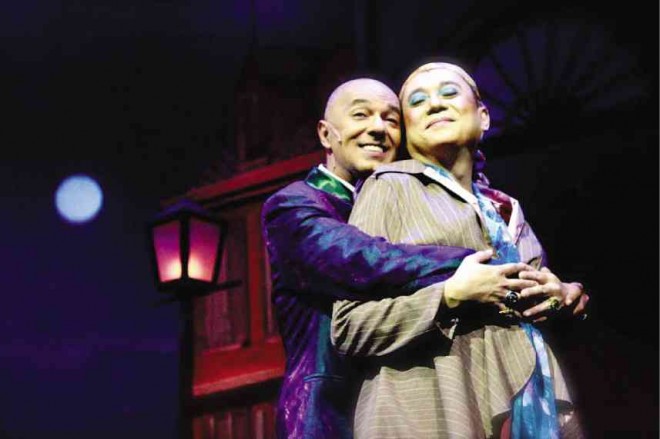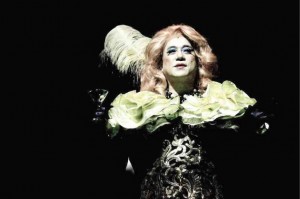
 The roar of greasepaint, the scent of the crowd entered with a bang in February, ushering a delectable selection of theater pieces; something the theater-going crowd had not experienced in a while, prompting director Peque Gallaga to play oracle, stating: “It is a golden age for theater!”
The roar of greasepaint, the scent of the crowd entered with a bang in February, ushering a delectable selection of theater pieces; something the theater-going crowd had not experienced in a while, prompting director Peque Gallaga to play oracle, stating: “It is a golden age for theater!”
Gallaga, like the growing handful of theater buffs, has often bemoaned the state of unsupported theater; the rather insipid, crowd-pleasing commercial forms of entertainment getting the larger piece of the sponsorship pie, over this refined and disciplined artform.
“Arbol de Fuego” and “Juego de Peligro,” two outstanding adaptations performed by equally sterling casts, were among the early offerings. The first, an adaptation of Anton Chekov’s “Cherry Orchard” by Rody Very, directed by Loy Arcenas and presented by Peta; and the second, the Filipinized adaptation of Pierre Choderlos de Laclos’ ” Les Liaisons Dangereuses,” by playwright Elmer Gatchalian, directed by Tuxqs Rustaquio for Tanghalang Pilipino.
Perhaps the “dark horse” on the program was 9 Works Theatrical’s “La Cage aux Folles.”
I approach remakes of critically acclaimed foreign productions with hesitancy because most of the time, the local versions almost always fall short of the glitz and talent of their foreign predecessors.
I was therefore only too happy to be proven wrong in this production of “La Cage aux Folles,” which did not just survive wonderfully in the shadow of its foreign sister, but, in fact, stood shoulder to shoulder with it.
It was a joyous jolt for a local theater production, as it literally featured an explosion of talent, never overdone, tastefully presented, despite its gender-sensitive subject matter.
The portrayal of homosexuality in theater or cinema usually pendulums between clichés of angst and caricature. But in this production, transvestitism is dealt with on an even keel, mainly because the lead actors chose to play on the humanity of their characters, rather than underscore their unusual gender as aberration, given to erratic behavior and exaggerated mannerism.
Michael de Mesa and Audie Gemora make for a perfect couple.
Gemora known for his intelligent and intense portrayals of serious characters, whether in plays or musicals, expands his repertoire, performing his role of Albin/Zaza not as a transvestite showgirl, but as a woman playing a transvestite showgirl.
In his role, this is what he puts across eloquently in his delivery of ” A Little More Mascara.” Henceforth, he establishes his woman comfortable in her skin.
Although Gemora has brilliantly sailed through singing roles such as “Sweeney Todd” or “Les Miserables,” in “La Cage,” he manipulates his voice in placements unheard of from him until this role, exhibiting a vocal range without hitting sharps or flats, and in well enunciated phrasing.
In character, he seems to channel familiar socialites and personalities without purposely doing so, for it all comes naturally, that he alleviates the uneasiness of having to watch an interpretation of femininity that many times comes off as vulgar.
True husband
De Mesa plays the “husband” George as a true husband, dedicated to his woman. With his singing and speaking voice, tenderly raspy, he comes off to every woman as the ideal man.
At the same time, he manages enough sleaze to come off as a smooth-talking owner of a drag queen bar. De Mesa, who seems to have lain low in theater over the past few years, has mellowed golden with maturity.
The chorus line, which can go over-the-top in a gay context, remained poised under high energy. There were no unnecessary hand-flailings or tress-tossing, scene-stealing or suggestive gestures, just pure dance in sustained character. Tackling several dance genres, the chorus (Cagelles) swung from Broadway jazz to tap to German cabaret.
Choreographers PJ Rebullida, Arnold Trinidad and Yek Barlongay nailed the dance routines with the correct placements for each genre, a feat in itself considering the various dance backgrounds of the chorus members: jazz, tap, ballet, contemporary and hip-hop.
They were a mix of gay and straight men as well, all in delicious drag costume in no-holds-barred glitz, thanks to the generous cooperation of the Fashion Designers Association of the Philippines. Beads and feathers in wanton abundance were on the verge of tack, yet elegantly camp.
Fringe Manila
A pleasant smorgasbord in this season of theater was the launch of Fringe Manila, an international festival of arts of all persuasions; open-access, non-curated performances in several venues scattered all over the city.
It was a showcase of anything fresh and daring whether in theater, poetry reading, music, dance and even visual arts. I was unable to catch a majority of the presentations, but what I saw of Daloy Dance Company was enough to make me regret that I didn’t see more.
“Canton” and “Himalaya” by the company’s artistic directress Ea Torrado are a study of contrasts in contemporary Filipino society.
“Canton” is an intense, uncomfortable work that emulates the lives of sex workers in Manila “wrought by oppression and the desperation that ensues.” It is a choreographed theater of cruelty that depicts the utter disrespect for human dignity by both the sex seeker and the provider.
The angular twitching steps and the punishing moves are painful to watch and the piece succeeds in putting across its aim of giving “form to narratives that are often ignored and left shapeless.”
The various shapes and sizes of the dancers, a marked feature in many experimental dance groups, work as an asset to the piece, adding to the mass of human desolation and entrapment in a world not to their liking but they are forced to survive in.
The jubilation that follows in “Himalaya” eases the pained contractions of the other piece, and suddenly the very same body shapes that formed a contorted mass now dance in unison in flowing ecru costumes: The dancers’ physical shapes, far from the ideal dancers’ body prototype (except for Brian Moreno, PJ Rebullida and Torrado herself, who have classic dancers’ physiques) seem uniformy proportioned.
Movements and phrasing are fresh and innovative; energy levels are swift and consistent, challenging the dancers’ bodies to explore its limits. Just when you think you’ve seen Tharp, it dissolves into a Cunningham, then swings back into Trisha Brown, and so on.
The steps are never of pure origin, just hints of intelligently inspired sets of contemporary dance movements.














































